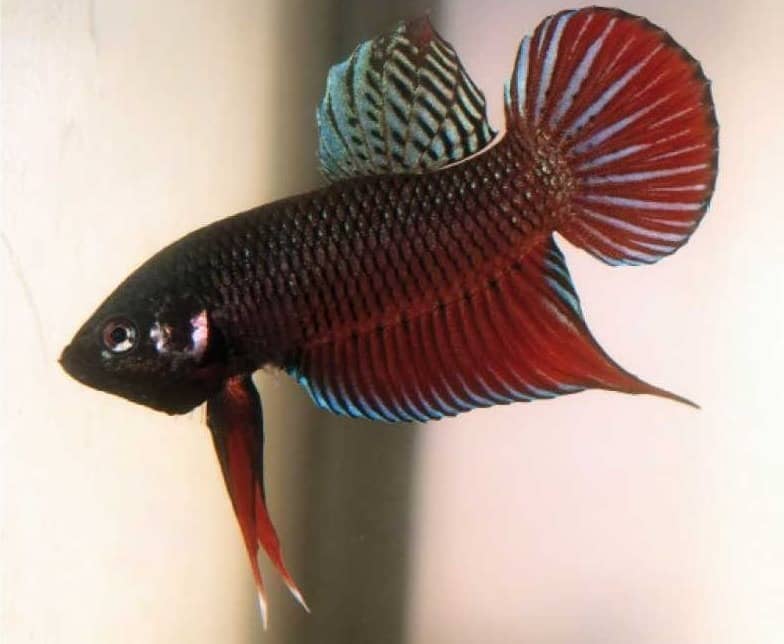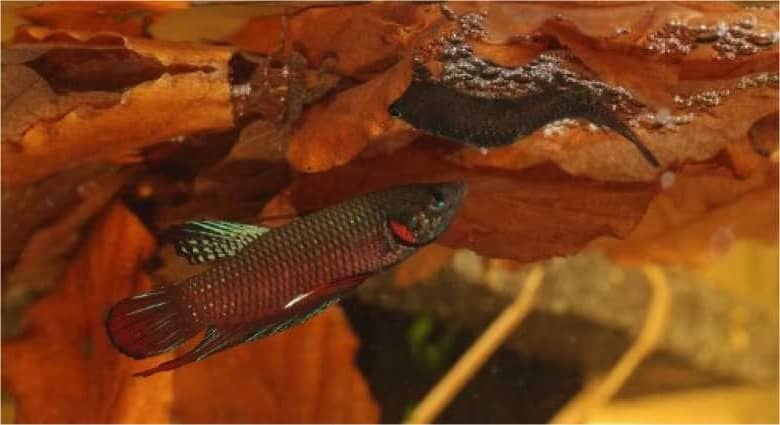The wild Betta fish is a stunning fish in its own right, with its dark body and fancy red and iridescent fins. I have seen wild bettas described as ‘drab,’ ‘dull’, and ‘nondescript’ in so many other fish books, and I have to say that I completely disagree. You can find why in this article. You have to remember that modern bettas are the result of hundreds of years of artificial selection by man.
Breeders have twisted the genetic make-up of bettas this way and that, constantly trying to arrive, that their own personal idea of the perfect fish. Wild bettas are a different story. They are the product of natural selection. Perfectly designed to live and reproduce in their natural habitat, they are pint-sized, pugnacious perfection.

Types of wild betta.
Jump To
- 1 Types of wild betta.
- 2 How wild betta became modern betta fish? History
- 3 Identify wild betta by fin rays
- 4 How long do wild betta fish live?
- 5 Where does wild betta live?
- 6 Natural Habitat.
- 7 Natural Habitat Conditions
- 8 Why do People Like Wild Betta Fish?
- 9 What Wild Betta Fish Eat?
- 10 Wild-type betta coloration
- 11 How to buy wild betta?
- 12 How do identify real wild fish?
- Pla Kat Par is a general term for wild Betta species. It thus usually refers to B. splendens, B. imbellis, or B. smaragdina.
- Pla Kat Tung is used to describe Betta splendens that have been collected from flooded fields, ditches, or marshes.
- Pla Kat Mor is the term for the domesticated strain of fighting fish (again betta splendens), which was traditionally bred in clay pots.
- Pla Kat Cheen is the term used in Thailand for the long-finned strains of Betta splendens (presumably because it was the Chinese who popularised this strain).
- Finally, Pla Kat Thai is the modern term for Thai fighting fish.
If you’ve ever seen photos of wild bettas or been lucky enough to see one in the flesh, then perhaps you can understand why many people who in keeping other Betta species refuse to keep domesticated varieties of Betta splendens in favor of the wild fish. Believe it or not, they find the modern strains ugly in comparison!
How wild betta became modern betta fish? History
In the early days of the sport, people would have collected wild bettas for fighting competitions, so there would have been little control over the fighting ability of the fish. I imagine it was largely a case of pot luck as to who had the best fish, with the most successful people being lucky enough to capture specimens.
That just happened to have the right balance of physical traits and fighting instinct to be winners. As the sport gained in popularity, with people betting larger and larger sums on the outcome of fights, the sensible thing to do would be to increase the odds of winning fights by ensuring your fighters came from winning stock.
This is how people first began to breed bettas in captivity selectively. But now betta fish is the breed for their beauty. Back then, they were breeding largely for fighting ability.

Identify wild betta by fin rays
In wild bettas (and domestic bettas with wild-type finnage), each primary ray usually branches just once into two secondary rays.
Such bettas are referred to as 2-ray bettas and are said to have primary branching (as this is the first time the caudal ray has split). Note that veiltail bettas are also 2-ray bettas.
How long do wild betta fish live?
In the wild, bettas probably have relatively short lives thanks to the effects of predation, damage sustained from fighting and/or spawning, and environmental effects. In pretty much all cases, domestic animals far outlive their wild counterparts. With this in mind, it would not surprise me if wild Betta splendens lived for two years, at the most.
The average lifespan of a captive-bred betta that is properly looked after in captivity is probably somewhere between two and three years. However, that is not to say that bettas can’t live for much longer than this.
Where does wild betta live?
Although, as one of its other common names suggests, the wild form of the Siamese fighting fish probably originates from Siam (or Thailand, as it is now known). The natural range of Betta splendens extends well beyond the Thai border into neighboring Cambodia, Laos, and Vietnam.
Wherever they are found, wild bettas tend to inhabit shallow water bodies that are choked with vegetation, such as swamps and rice paddies. So ideal are rice paddies for bettas that I would wager that both the history of rice farming and the history of betta keeping in south-east Asia are the close links.
After all, what better way for people to first come into contact with bettas than as a result of seeing them swimming amongst the stems of rice plants?
Natural Habitat.
Betta habitats are generally oxygen-poor as a result of the increased rate of evaporation of gases brought about by a combination of shallow water and high air temperature. From an evolutionary point, it is likely that this deficit in dissolved oxygen was a major selective force in the evolution of the labyrinth organ found in all Anabantoid fishes.
This enables these fish to utilize atmospheric air for respiration. Whatever the common ancestor of this group of fishes It would be reasonable to assume that it inhabited oxygen-poor waters, where genetic mutations that enabled it to utilize atmospheric oxygen would convey a huge survival advantage over less well-equipped individuals. In any case, an ability to survive in far shallower water than other fish species has allowed the Anabantoids to occupy environments where competition for resources from other fish species is much lower.

Natural Habitat Conditions
The tropical weather conditions in the betta’s natural range result in extreme variation in water availability, clarity, chemistry, and temperature. The rainy season typically lasts from May through to October; air temperatures range from 15°C in December to 40°C in April.
The water hardness can vary from pH 6.9 to pH 8.2. These great environmental fluctuations have played a crucial part in making the betta a fish that is highly adaptable to a wide range of aquatic environments. This adaptability is also seen in captivity and is one of the main reasons for the popularity of this species among novice and experienced aquarists alike.
When I first began to research and keep bettas (20 years ago!), all the books I read talked about bettas living in oxygen-poor, rather acidic water conditions. In my mind, I imagined relatively clear, un-vegetated, shallow pools of water, dyed brown from the tannins released by fallen leaves. Now that I have seen the actual betta habitat, I know that nothing could be further from the truth.
Through researching, I have learned that bettas actually inhabit shallow water bodies that are literally chok with emergent aquatic vegetation. I had always wondered how a body of water could sustain a population of Betta splendens when this species is so famous for the inability of males to tolerate one other without confrontations escalating into fights.
In the betta habitat of my imagination, males would see each other regularly and spend all their time-fighting. In reality, the sheer density of plants may mean that males are often hidden from each other’s view by vegetation, enabling a higher density of territories than would be possible in an open water body, devoid of plants.
Why do People Like Wild Betta Fish?
Firstly, bettas are highly adaptable fish that have been able to colonize water bodies all over the world successfully. Due to their tolerance of wide water parameters and the possession of a lung-like labyrinth organ, which enables them to breathe atmospheric oxygen.
Secondly, bettas naturally inhabit shallow, slow-moving waters that are low in dissolved oxygen and of relatively high temperatures. Thirdly, betta habitat contains a high density of emergent aquatic vegetation, which is likely to act as a screen between aggressive males, provide protection for females from males during spawning, and provide cover for fry as they grow.
Keep these three lessons in your mind, as they have shaped the manner in which we keep bettas in captivity.
What Wild Betta Fish Eat?
The diet of wild bettas consists almost entirely of aquatic crustaceans (freshwater shrimps) and insect larvae. There are three ways to replicate this diet in captivity. The first is to buy the organisms in frozen form (either as cubes or slabs) from your local fish store.
The companies that make frozen food blocks do so by harvesting or farming vast quantities of live foods, washing away any dirt and debris, and then freezing them for sale to the aquatics trade. Although more expensive than dried foods, frozen foods are an excellent way of introducing variety into the diet of your bettas.
The following types of frozen food are suitable if you have a wild betta captive.
- Adult brine shrimp (Artemia)
- Glassware
- Black mosquito larvae
- Bloodworm
- Tubifex
- Daphnia
- White mosquito larvae
- Mysis shrimp
- Beef-heart
- Cyclops
Wild-type betta coloration
Wild-type bettas, as I mentioned above, show some degree of pigmentation in all of the skin layers. Wild Betta splendens have a different arrangement of the pigment layers when compared with domesticated bettas; namely that the black and red layers are reversed.
With red on top and black beneath. I have as yet been unable to find any scientific support for this theory, and therefore, for the sake of simplicity, I have chosen to ignore it, particularly as I can see no biological reason why this should be the case. Wild-type bettas (by which I mean wild bettas and domesticated forms with wild-type appearance) tend to have a rather fixed coloration and are pretty hard to mistake.
Typically they have a dark brownish red body with iridescence in the dorsal half, and a combination of red and iridescence (royal blue, turquoise, or steel blue) in the three unpaired fins. The ventrals are typically red with white tips.
Whichever way round the black and red layers are, the brownish-red body color is the result of both layers expressing pigment to some extent. The iridescent layer is always on top. Note that the head region in wild types is usually darker i.e. there is either less red pigmentation or black pigmentation in the anterior half of the fish.
A whole bunch of genes is involved in producing the wild-type coloration. The take-home message is really that all of the other colors and color patterns we will discuss are the results of mutations in the wild-type (here meaning ‘as found in the wild’) version of the genes controlling coloration. As there is no single allele for ‘wild-type coloration’, it follows that there is no allele symbol to signify wild-type coloration.
How to buy wild betta?
You need to buy wild betta fish from a reputable seller. It is unlikely that you will ever buy a truly wild betta. Most wild-type bettas for sale in the West probably come from fighting fish stocks which, although similar in appearance to wild fish, are actually the result of many years of selective breeding for traits that make better fighters.
As such, if you see a fish that looks superficially like a wild Betta splendens, you should refer to it as a ‘wild-type’ betta unless you know for sure that it caught in the wild.
How do identify real wild fish?
A wild-type betta is a dark-bodied fish with red and iridescent blue/green fins and a dusting of iridescent blue/green scales on the dorsal (upper) half of the body.
Male:
- The unpaired fins are short, but the ventrals are relatively thin and long.
- The dorsal fin is round or slightly pointed to the rear.
- The caudal fin is round or slightly pointed in the middle, and each caudal ray only splits in two once before reaching the edge of the fin (primary branching).
- The first rays of the caudal fin (at the top and bottom of the fin) are round and often relatively short.
- The anal fin is trapezoid in shape, shorter at the front and pointed at the rear, with the tip extending beyond the lower edge of the caudal fin.
Female:
- Female fish are similar to male fish but have far shorter unpaired fins and short ventrals.
- Wild and wild-type bettas all carry two copies of the short-fin allele, which is a recessive allele and causes bettas to have short fins.
- Because the term given to domesticate short-fin bettas is ‘plakat’, .this gene is also sometimes referred to as the plakat allele.
if you are interested please find out more about the below betta fish types.
Also, see our guide about Oscar Fish
